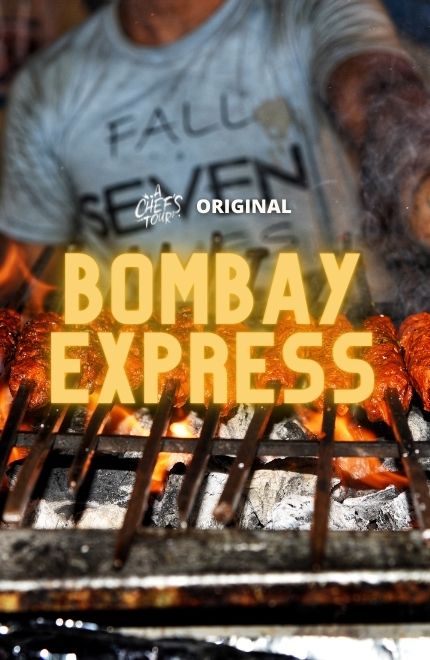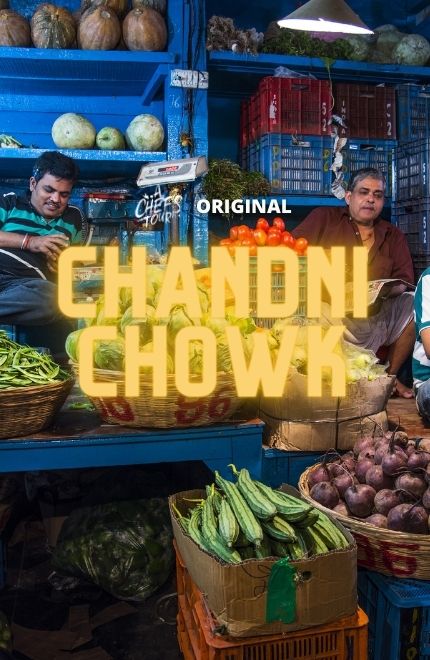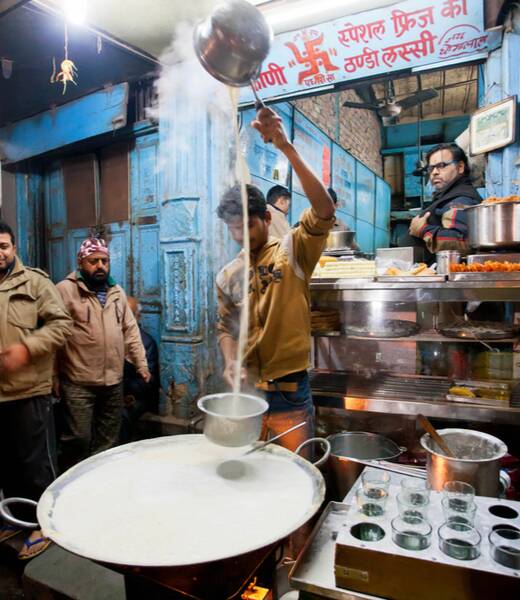One of the world’s most populous cities, Mumbai is home to almost 20 million people, 7.5 million of whom commute to and from work every weekday. As a result, the metropolis’s public transport system, with its snaking grid of trains and tubes, is fit to burst, ferrying its cargo around like so many red blood cells in a vast network of veins and arteries. It’s an immense but incredibly organised species of chaos.
As well as making sure all these employees arrive at their workplace on time, another necessity is guaranteeing they’re equally well fed and watered. Step forward the humble but hallowed Mumbai dabbawala – “one who carries a box” – who form a community of over 5,000 brethren responsible for delivering as many as 200,000 meals every single lunchtime. Dispensing with all forms of technology that are more sophisticated than a locomotive, the sprawling team feed the city’s workforce on schedule and without making mistakes, time and time again.
You can meet the dabbawallas and watch them work on our highly-rated Mumbai food tour.
History of the dabbawala
The idea of the Mumbai dabbawala came about during the time of the British Raj in the late 19thcentury. The city’s population was swelling with an influx of hungry workers, who had varying levels of education and no restaurant or fast food culture to feed them come lunchtime. As a solution, a Bombay banker named Mahadeo Havaji Bachche decided he would have home-cooked food delivered to his office and the idea quickly gained popularity among his co-workers and beyond.
Sensing a business opportunity, Bachche proved himself a visionary by launching the first ever dabbawala service comprised of 100 workers in 1890. In the intervening 129 years, the system has grown to an incredible size and is estimated to be responsible for over 50 million deliveries per year – or double that if you factor in the return journeys carrying the empty boxes. Dressed in distinctive white cotton kurta (pyjamas) and finished off by a similar white topi (Gandhi cap), the dabbawalas ferry their dabbas (tiffin boxes) all over the city without the aid of apps, GPS or any other technological jiggery-pokery.
Most remarkable of all, the dabbawala system functions with remarkable precision, despite its primitive mechanisms. According to the general secretary of the Mumbai Dabbawalla Association, the workers operate at a rate of 99.99% efficiency, while even the Harvard Business School granted Mumbai dabbawala six sigma status, meaning there are less than 200 errors each year. No wonder FedEx and Amazon have looked to the dabbawala model to gain insights into how to optimise their own operations.
A day in the life
Those figures are all the more impressive when you remember that the vast majority of those working in the industry are semi-literate, with the average education level comparable to that of a 13-year-old. What dabbawalas do possess is the passion to do their job well and the fierce determination to make their deliveries on time.
The day starts fairly early, with many dabbawalas rising at dawn to pray, exercise or enjoy other personal leisure activities. A carb-heavy breakfast is a must given the intensive routine that is to follow, with their rounds commencing around 8am. After collecting all of the scheduled lunchboxes on their route, the dabbawalas head to the nearest train station to congregate with their colleagues, where the boxes are collated, organised and sorted into location-specific piles.
Here’s where it really becomes ingenuous. Since many of the workers struggle with reading written language, the boxes are marked using a system of colour-coded alphanumeric symbols, each denoting the collection point where the box was originally obtained, the train station it must now head to, the destination train station where it should be unloaded and finally the exact address (including office floor and number) of its recipient. This complex method of organisation would be incomprehensible to the uninitiated but can be read and understood at a glance from a seasoned dabbawala, simplifying and streamlining the process to ensure minimal slip-ups.
Once marked, the dabbas are placed on their respective trains and sent off to their destinations, where a team of local dabbawalas will be waiting to complete the final leg of their journey. The deadline for delivery is 1pm at the very latest and most dabbawalas will set themselves a conservative target which allows plenty of margin for error to account for unforeseen traffic hold-ups or other delays, giving themselves the best chance of keeping their record clean.
Once the final delivery has been completed, it’s time for the dabbawala to enjoy a well-earned rest and respite with lunch of his own, before the process will be done all over again, this time in reverse. The empty lunchboxes are now collected and returned to their original destinations, ready to repeat the circuit once again the following day.
Social status
It’s an exhausting job – but one that isn’t without its own rewards. Although the service is eminently affordable for those who partake of it (approximately 500-800 rupees or £5.80-£9.30 per month, depending on distance covered), the dabbawalas receive a wage of 8,000-12,000 rupees (£90-£140) per month.
What’s more, the job security associated with being a dabbawala is outstanding. Given that it’s part of a cooperative, each dabbawala is self-employed – no “Yes sir, no sir” to anyone – and it’s viewed as a job for life. Best of all, dabbawalas carry with them a certain prestige for the valuable work they carry out in the city. As well as translating into occasional monetary benefits (discounted mobile phone tariffs, scholarships for their offspring), this is most noticeable on the street itself.
Anyone coming into contact with a member of this noble profession in traffic will immediately give way or help to clear their path. Such behaviour is pretty much unthinkable in other countries around the world, but it’s testament to the high regard in which dabbawalas are held that their social status among their peers is secured.
The future remains bright
With the rise of food delivery apps such as Uber Eats and Deliveroo in other parts of the world, it’s feasible that the dabbawala empire could soon be subject to similar competition on their own patch. Indeed, homegrown food delivery companies such as Runnr and Swiggy, both of which are endeavouring to combine the efficiency of the existing dabbawala system with the power of technology, have begun to make inroads into the industry.
Even so, the future still looks rosy for the omnipresent and indispensable dabbawala. Despite the increased competition, the number of dabbawalas on Mumbai streets has been showing continued growth of between 5% and 10% each year, with no signs of stopping. With the advantage of using bicycles, trains and their feet to circumvent the traffic jams that scupper motorbikes and cars, and with the unique selling point of home-cooked lunch delivery, Mumbai dabbawalas look set to go from strength to strength for the foreseeable future and beyond.
Where to see the dabbawalas
Churchgate Station
If you just wander around the streets of Mumbai, you'll likely spot a dabbawala at work. But to see the real action, head down to Churchgate station in the morning or afternoon. Many dabbawalas congregate outside sorting their lunch boxes ready to be delivered or returned.

Want to truly explore the Mumbai food scene? Consider joining this daily Mumbai food tour and spend four hours diving into the street food, old cafes and markets of the city with the help of an expert local food guide.

A Chef's Tour
Sign up for our newsletter.






